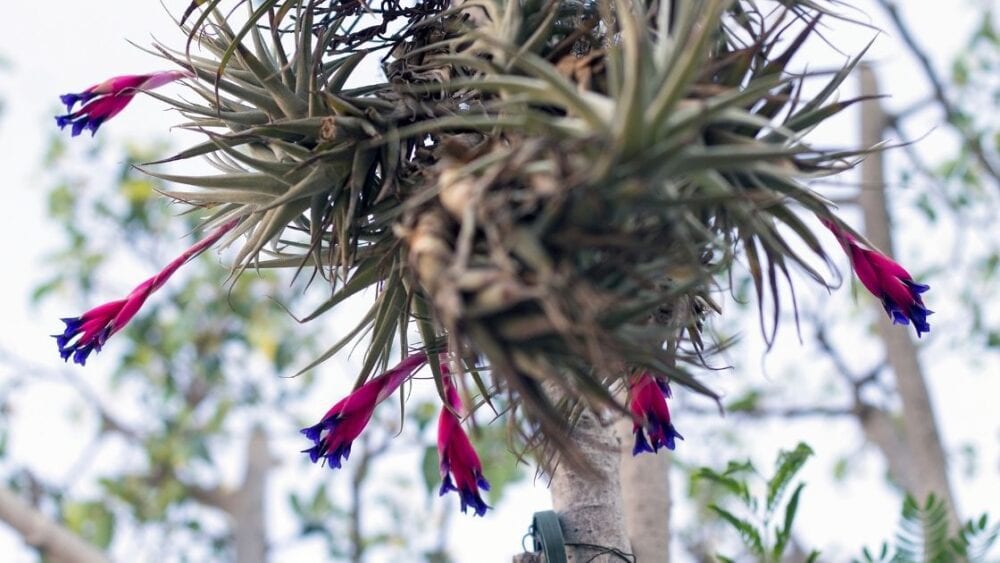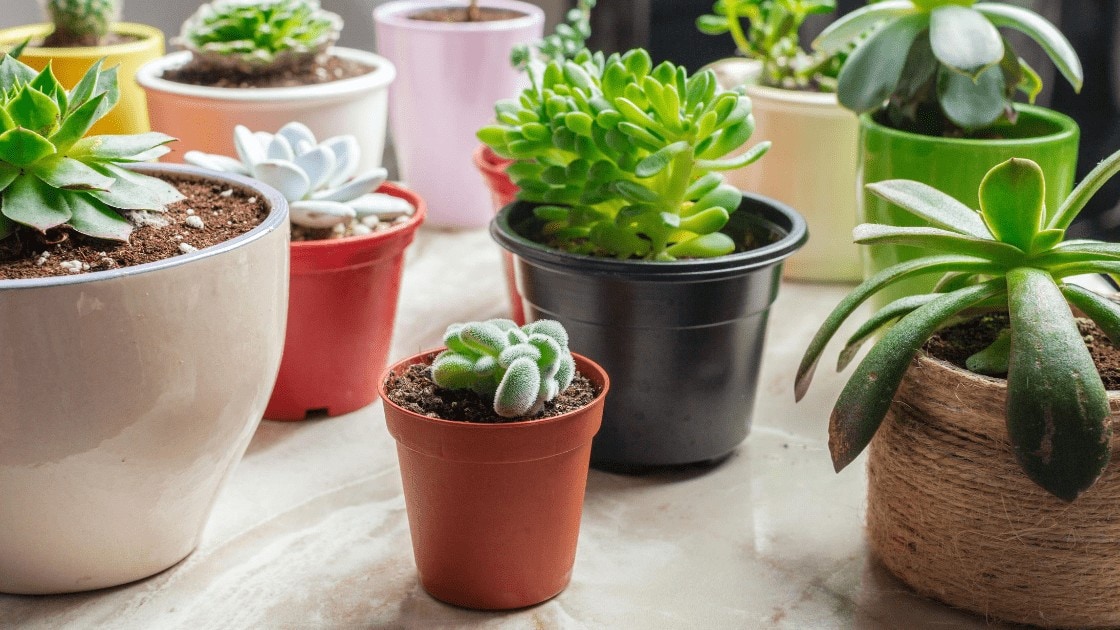
Tillandsias aren’t long-living – they usually grow actively for 2 to 3 years, after which they bloom and die. Before dying, they form small offsets (pups), which can be used to give life to the next generation. It’s not completely clear how long this cycle can continue, before a generation stops forming offsets and has to be started from seeds. The reason air plants die after blooming is because they use all of the energy and nutrients stored in the leaves for the formation of the flowers.
Sometimes, offsets are not produced and the plant dies immediately after, or during blooming. Most Tillandsia species are not self-fertile and have a built-in incompatibility with their own pollen. They will not form seeds without being pollinated by a genetically separate specimen. A few species, like T. polystachia are an exception and have been reported to self-pollinate without any issues.
How Long Can They Go Without Water or Light?
An air plant can go 2-3 weeks without water, but this is highly dependent on the air humidity, air drafts and light levels.
Browse our Affiliate Products
Even fully dehydrated plants, which have been starved of water for months, can be successfully revived by submerging them in a tub for several hours. This, however, is not 100% reliable. Without light, air plants will stop growing, lose their coloring and die after about 2 months.
Do Different Varieties Have Different Lifespans and Growth Rates?

There are several hundred air plant species (all part of the Tillandsia genus). Some of them only live for a few months, but most of the species which can be purchased from stores live for at least a few years. Those species also tend to produce many offsets (‘pups’), which make propagation easy. In colder environments and with less fertilization, Tillandsia will grow slower, live longer and flower later.
For more information on Tillandsia Xerographica, checkout this article. Tillandsia Xerographica: The Famous Air Plant
Air Plant Care
It’s easy to tell if an air plant is happy – the deep, healthy colors, combined with the abundance of trichomes along the whole surface of the plant are good signs. Despite being exotic, tropical plants, air plants are very easy to care for.
Can air plants be grown outdoors?
Most air plants are very small (several inches tall) and are mostly suitable for indoor growing.
However, there are larger species, which can be suitable for outdoor growing during the warmer months. T. Xerographica, T. jalisco-monticola and a few dozen others can reach around 2 feet in size, making them suitable for outdoor spaces during the summer and spring. Air plants can’t tolerate frost.
Sunlight requirements
The brightest possible indirect sunlight will result in the fastest growth. Air plants are very inefficient at photosynthesis – not only do they photosynthesize in the same way as succulents (CAM photosynthesis), but they also tend to have a layer of trichomes along their leaf surface, which further block the incoming light. Direct sunlight, filtered through a window can work well during the winter months.
Direct sunlight can work during the summer as well, but avoiding heat stress and dehydration can be difficult, especially in air-conditioned rooms with low air humidity.
Feeding/fertilization
From a scientific standpoint, the nutrition of Tillandsia is quite complicated – most species rely on dust particles as a mineral source and on the ammonium produced by nitrogen fixing bacteria as a nitrogen source. However, in practical terms, feeding an air plant is easy – simply submerge the plant in a 1/4 strength solution of a regular plant fertilizer or use a mister.
Fertilizers with ammonium-based nitrogen, which provide all 6 micro-nutrients work best. However, unlike most other plants, Tilandsia dislikes calcium – for that reason, highly mineralized tap water and calcium-containing fertilizers should not be used. Most growers, like to use Bromeliad-specific fertilizers for air plants. Without any fertilization, Tillandsia is unlikely to grow or bloom in indoor conditions.
Watering methods and ideal watering frequency
Air plants have water-preservation strategies very similar to those of succulents – they perform the same type of photosynthesis, called CAM (crassulacean acid metabolism). During the daytime, all of their pores are completely closed. They lose water only at night, when the temperatures are lower. Therefore, air plants are relatively resistant to dehydration and most can survive at least 2 weeks with no water at all.
Misting every other day works best for most Tillandsia species. Misting too frequently (multiple times a day) and keeping the foliage constantly wet is a big mistake – this is unnatural for the plant and a drought period is necessary to keep mold and bacteria in check. Some people prefer to water their air plants by submerging – this can be very practical for smaller plants. Submerging the plant once a week for an hour works well.
What to do if your air plant blooms

Air plant flowers are beautiful, but blooming is a rare event, during which the plant spends all of its energy and dies.
If your air plant blooms, the best thing to do is to look for offsets (pups) and cut them off. Those offsets will grow into mature plants and will eventually have pups of their own. You can play around with pollinating the flowers of your air plant, but obtaining seeds is sometimes impossible – most Tillandsia species are not self-fertile and reject their own pollen.
Common Problems When Caring For Air Plants
In many ways, air plants can actually be easier to care for than potted plants – they don’t succumb to root rot and the factor of soil quality is taken out of the equation. Most of the problems with air plants are very basic, easy to diagnose and solve.
Light deficiency
Manifests itself as loss of color and complete lack of growth. Ambient, room light is not enough for air plants and a close proximity to a window is required. LED grow bulbs are an excellent option for small Tillandsias.
Dehydration
Can occur if the plant hasn’t been misted or submerged in water for more than a week or two. Submerging it underwater for an hour usually brings it back to life, but an additional recovery period of a few weeks will be necessary for the air plant to start looking good again.
Rotting problems
Due to too frequent water applications are common – never mist or water your air plants more than once every other day.
Fertilizer burn
can occur because of too frequent fertilizer applications with a mister. This leads to accumulation of fertilizer salts, which are left behind every time the droplets evaporate. Submerging the plant in plain water for a few minutes takes care of the problem. Some fertilizer are not suitable for air plants and can cause issues. Those include calcium-containing ones and urea-based ones.
Pests
Are uncommon, but not unheard of in air plants. Because of the trichome-rich, rough surface of the leaves, soap washing and alcohol sprays aren’t as suitable for air plants. A strong pesticide is usually the best option. Powdered diatomaceous earth can be an effective, natural solution.
Final Thoughts
Air plants are easy to care for and usually live for 2 to 4 years – after this, they bloom and die, but can be re-started from the pups they put out. Very bright, indirect light is extremely important for air plants and so are regular applications of dilute fertilizer.









